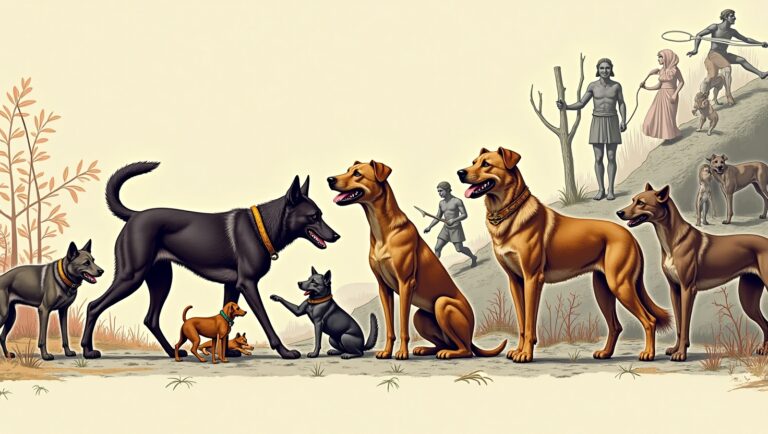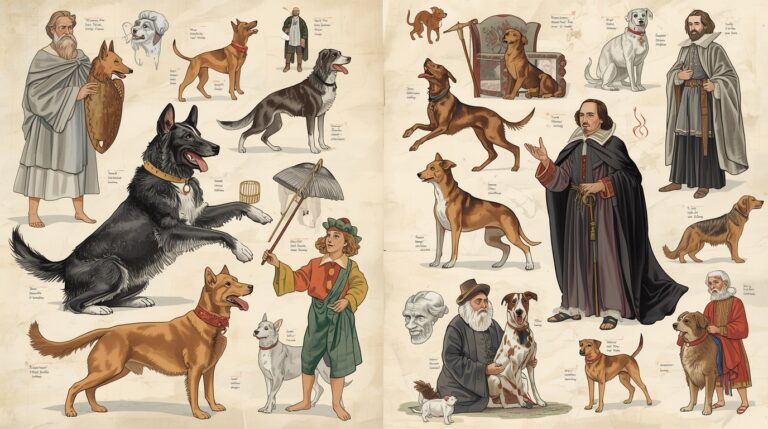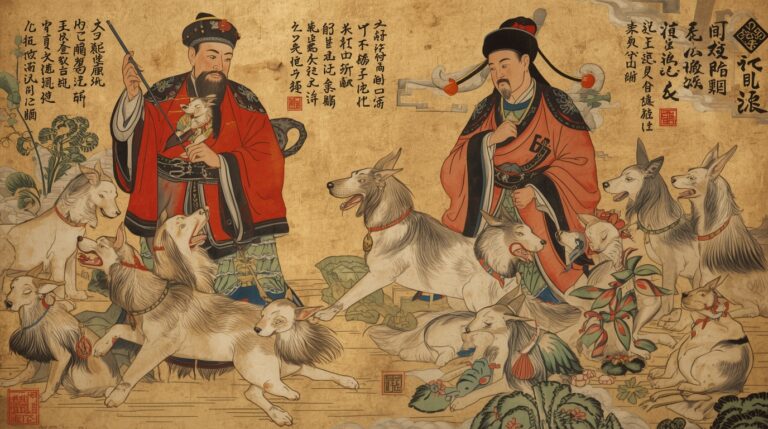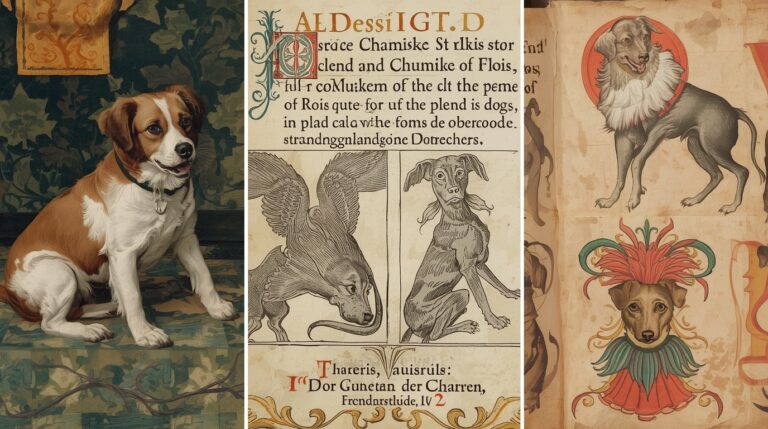Royal and Noble Dog Companions in the Renaissance

Introduction: Dogs at the Heart of Renaissance Nobility
During the Renaissance, dogs emerged as powerful symbols of nobility, loyalty, and refined emotion. While earlier eras often valued dogs for their practical hunting abilities, Renaissance courts embraced dogs as intimate companions and icons of humanistic thought. In royal bedrooms, on tapestries, and beside thrones, dogs were not only cherished but also deeply symbolic—mirrors of courtly values, private emotions, and dynastic identity.
The Renaissance Court and Domestic Animals
Court life in Renaissance Europe was defined by elaborate rituals, art, and diplomacy. Amid the glittering fabrics and court dances were small, finely bred dogs, quietly occupying laps, beds, and portrait frames.
- Dogs were welcomed into private chambers, gardens, and even audience halls.
- The era’s rising humanist philosophy fostered emotional bonds with animals, viewing dogs as sentient, moral beings.
The Rise of Companion Dogs in Renaissance Europe
As hunting shifted from necessity to leisure, lapdogs and companion breeds gained popularity.
- Nobles increasingly favored small dogs that could live indoors and serve as status symbols.
- Dogs became a visual representation of the emotional interior of the Renaissance aristocrat—affectionate, loyal, and noble in demeanor.
Popular Dog Breeds Among Royalty and Nobles
Several breeds flourished in Renaissance noble circles:
- Greyhounds: Symbolized grace and nobility; featured in hunting and portraiture.
- Maltese and Bichons: Associated with noblewomen for their compact size and pristine coats.
- Toy Spaniels: Favored by English and French courts for companionship and beauty.
These dogs were chosen not only for appearance but also for their temperament and symbolic alignment with court ideals.
Dogs in Royal Portraiture
Painters used dogs in portraits to convey personal attributes and family identity:
- Lapdogs in women’s portraits suggested chastity, domestic virtue, and sensitivity.
- Hounds in men’s portraits emphasized strength, discipline, and noble leisure.
- Artists like Titian, Bronzino, and Holbein included dogs to humanize sitters and emphasize loyalty.
Catherine de’ Medici and Her Court Dogs
Queen Catherine de’ Medici was known for her devotion to her lapdogs.
- She kept multiple Bichon Frises and Italian Greyhounds at court.
- Portraits depict her dogs as constant companions, present during court business, mourning, and diplomatic meetings.
Her affection symbolized both maternal care and personal refinement.
Elizabeth I and Symbolic Canine Imagery
Queen Elizabeth I often posed with small dogs, particularly Spaniels, in her portraits.
- These dogs enhanced her image of virgin purity and steadfastness.
- In some depictions, dogs rest at her feet as visual anchors of her sovereign loyalty and virtue.
Dogs in the House of Valois and Bourbon Courts
The French royal courts favored dogs as part of their artistic and diplomatic culture.
- Tapestries and miniatures from these courts feature dogs in ceremonial and domestic contexts.
- Dogs often symbolized dynastic stability and feminine elegance, especially in portraits of young noblewomen.
Italian Courts and the Lapdog Renaissance
Italian city-states like Florence, Mantua, and Ferrara celebrated the lapdog as a cultural accessory.
- The Medici family maintained kennels of companion dogs bred for appearance and demeanor.
- Court painters included dogs in nearly all female portraits, linking them with chastity, loyalty, and wealth.
Royal Children and Their Puppies
Children of the nobility were frequently painted with dogs:
- Puppies symbolized innocence, affection, and future responsibility.
- Such images humanized royal heirs and showcased tenderness in dynastic lineages.
Lapdogs and Noblewomen’s Symbolism
Dogs were integral to the imagery of noble femininity:
- Sleeping dogs in portraits represented marital peace.
- Groomed lapdogs signaled courtly grooming standards and emotional refinement.
- Their presence provided a counterbalance to opulent garments, grounding the sitter in domestic virtue.
Court Etiquette and Dog Behavior
Dogs had to follow court protocol:
- Quiet breeds were preferred for audiences and receptions.
- Disruptive behavior by a dog could reflect poorly on its owner, affecting court standing.
Royal dogs were groomed daily, wore embroidered collars, and were trained by dedicated handlers.
Dogs as Dynastic and Marital Symbols
In wedding portraits:
- Dogs symbolized loyalty within marriage.
- They were sometimes gifted as part of a dowry, reinforcing the alliance between families.
- Some portraits show both bride and groom each holding a dog, suggesting mutual devotion.
Canine Gift-Giving in Royal Diplomacy
Dogs were valuable diplomatic gifts:
- Queen Elizabeth I reportedly sent Maltese dogs to European princes.
- King Henry III of France received lapdogs as part of peace negotiations.
- These exchanges symbolized goodwill, loyalty, and shared refinement.
Dog Breeding and Kennel Management in Royal Estates
Royal kennels were managed with precision:
- Breeding was documented for temperament and appearance.
- Dedicated staff ensured grooming, dietary needs, and medical care.
- Some dogs had named quarters, and particularly favored pets were buried with ceremony.
Dogs in Noble Literature and Diaries
Letters and journals from noblewomen often mention:
- Personal attachment to their dogs
- The emotional void left by a beloved companion’s death
- Descriptions of dog personalities, playfulness, and quirks
These writings reflect the intimate bonds formed across the courts of Europe.
Dogs in Religious and Moral Symbolism
In religious art commissioned by nobles:
- Dogs symbolized faith, fidelity, and moral vigilance.
- Scenes of the Madonna and Child occasionally included dogs as metaphors of divine guardianship.
This reinforced the moral alignment of courtly life and Christian values.
Canine Loyalty in Tragedy and Mourning
After the death of a spouse or monarch:
- Dogs appeared in mourning portraits as symbols of enduring loyalty.
- Some nobles commissioned paintings of their late dog, emphasizing the animal’s emotional significance.
These images preserved the memory of bond, portraying the dog as mourner and spiritual ally.
Dogs in Heraldry and Noble Identity
Dogs were incorporated into:
- Coats of arms: Especially Greyhounds, Talbots, and Spaniels
- Family crests: Embodying steadfast loyalty, watchfulness, and devotion
They served as both personal totems and public declarations of character.
Dogs in Court Fashion and Accessories
Dogs influenced court fashion:
- Jeweled collars and silk leashes adorned favorite pets.
- Portraits included dog-shaped brooches, embroidered sleeves, and canine-motif tapestries.
- Some royal dogs had custom-built beds and traveled in gilded carriages.
These details underscored dogs’ role as extensions of noble identity.
Conclusion: The Dog as Mirror of Renaissance Nobility
In Renaissance courts, dogs became reflections of the human soul. They embodied the values of loyalty, refinement, affection, and symbolism that permeated noble life. Whether seated at the foot of a monarch, nestled in a lady’s lap, or painted in a dynastic portrait, the royal dog companion stood not just as a pet—but as a living metaphor for virtue, lineage, and love.





